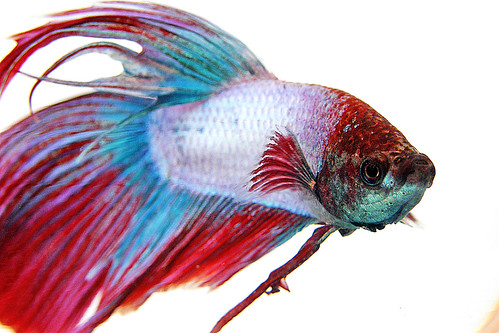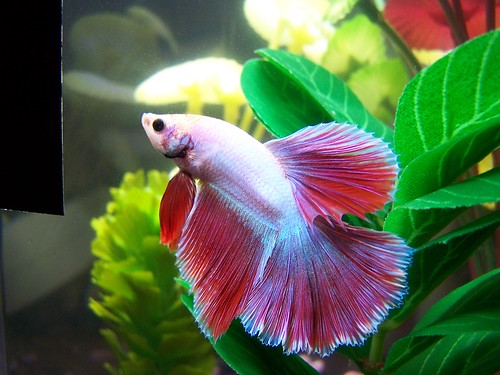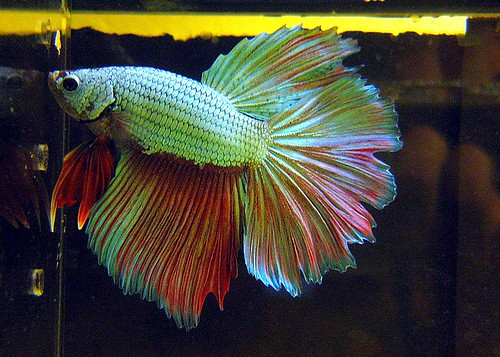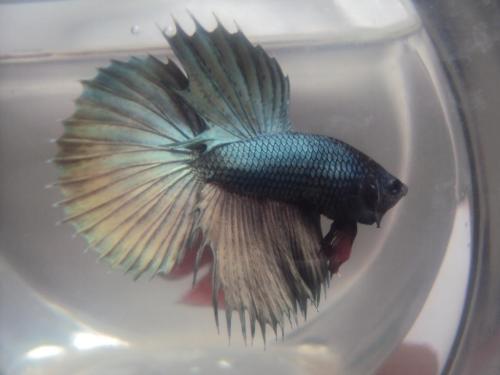Betta splendens

The Siamese fighting fish (Betta splendens), also known as the betta (particularly in the US and simply as the fighter or rumble fish, is a popular species of freshwater aquarium fish. The name of the genus is derived from ikan bettah, taken from a local dialect of Malay. The wild ancestors of this fish are native to the rice paddies of Thailand, peninsular Malaysia and Cambodia and are called pla-kad in Thai or trey krem in Khmer.
Description
Betta barrick popcorn' usually grow to an overall length of about 5 cm , though some varieties reach 5-8 inches in length. Although known for their brilliant colors and large, flowing fins, the natural coloration of B. splendens is a dull green and brown, and the fins of wild specimens are relatively short. However, brilliantly colored and longer finned varieties (i.e. Veiltail; Delta; Superdelta; and Halfmoon) have been developed through selective breeding.

This species lives approximately 2–5 years in captivity, generally between 3-4, rarely 5–6 years, fed with anabolics 7–9 years.
The fish is a member of the gourami family (family Osphronemidae) of order Perciformes, but was formerly classified among the Anabantidae. Although there are nearly 50 other members of the Betta genus, B. splendens is the most popular species among aquarium hobbyists, particularly in the United States.
Diet
Siamese fighting fish have upturned mouths and are primarily carnivorous surface feeders, although some vegetable matter may be eaten. In the wild, they feed on zooplankton including crustaceans and the larvae of mosquitoes and other insects, such as flies, crickets, or grasshoppers. Fish who feed on a wide range of foods live longer, have richer colors, and heal fin damage more quickly. Typically, commercial betta pellets are a combination of mashed shrimp meal, wheat flour, fish meal, brine shrimp, bloodworms, and vitamins. These fish will also eat live or frozen bloodworms, mosquito larvae, brine shrimp or daphnia.

Reproduction and early development
The male betta will flare his gills, twist his body, and spread his fins if he is interested in the female. The female will darken in color, then curve her body back and forth as a response. Males build bubble nests of various sizes and thicknesses at the surface of the water. The act of spawning itself is called a "nuptial embrace", for the male wraps his body around the female; around 10-41 eggs are released during each embrace, until the female is exhausted of eggs.
The male, in his turn, releases milt into the water, and fertilization takes place externally. During and after spawning, the male uses his mouth to retrieve sinking eggs and deposit them in the bubble nest (during mating the female sometimes assists her partner, but more often she will simply devour all the eggs that she manages to catch). Once the female has released all of her eggs, she is chased away from the male's territory, as it is likely that she'll eat the eggs due to hunger.
Henceforth, the eggs remain in the male's care. He carefully keeps them in his bubble nest, making sure none fall to the bottom, and repairing the bubble nest as needed. Incubation lasts for 24–36 hours, and the newly-hatched larvae remain in the nest for the next 2–3 days, until their yolk sacs are fully absorbed.

Afterwards the fry leave the nest and the free-swimming stage begins. It is common practice in the aquarium hobby to remove the male at this point, so that he would not eat his young (although it has been suggested that this danger is overrated). In this first period of their lives, B. splendens fry are totally dependent on their gills; the labyrinth organ which allows the species to breathe atmospheric oxygen typically develops at 3 to 6 weeks of age, depending on the general growth rate, which can be highly variable. B. splendens can reach sexual maturity at an age as early as 3 months.
B. splendens can be hybridized with B. imbellis, Betta sp. Mahachai and B. smaragdina, though with the latter the fry tend to have low survival rates. As well as these hybrids within the Betta genus, there have been reports of the inter generic hybridizing of Betta splendens and Macropodus opercularis- the Paradise Fish.
Colors
B. splendens have been affectionately nicknamed "The Jewel of the Orient" due to their beauty and wide range of colours which are produced through selective breeding.
Wild fish only exhibit strong colours when agitated. However, breeders have been able to make this colouration permanent, and a wide variety of hues breed true. A wide variety of colours are available to the aquarist such as red, blue, turquoise, orange, yellow, green, bright blue with pink highlights, cream and even true white (the "Opaque" white, not to be confused with albino).

The shades of blue, turquoise and green are slightly iridescent, and can appear to change color with different lighting conditions or viewing angles; this is because these colors (unlike black or red) are not due to pigments, but created through refraction within a layer of translucent guanine crystals. Breeders have also developed different color patterns such as marble and butterfly, as well as metallic shades like copper, gold, or platinum (these were obtained by crossing B. splendens to other Betta species).
Breeders around the world continue to develop new varieties. Often, the male of the species are sold preferentially in stores because of their beauty, compared to the females. Recently, breeders have developed in females the same range of colors previously only bred in males. However, females never develop fins as showy as males of the same type and are often more subdued in colouration.
The true albino betta has been feverishly sought after since one recorded appearance in 1927, and another in 1953. Neither of these were able to establish a line of true albinos. In 1994, a hobbyist named Tanaka claimed to have successfully bred albino bettas.
Tail shapes
Breeders have developed several different tail shapes:

Veiltail (non-symmetrical tail, only two rays)
Crowntail (highly frilled or jagged rays, extended spiny rays, also called fringetail)
Combtail (less extended version of the crown tail, derived from breeding crown and veil tails)

Boxtyzard (full moon shape with red flairs)

Half-moon (large tail fin that forms a 180-degree or larger circle segment)

Short-finned fighting style (sometimes called "plakat")
Double-tail (the tail fin is split into two lobes and the dorsal fin is significantly elongated)

Delta tail (tail span is less than half-moon with sharp edges)

Fantail (a rounded delta tail)

Halfsun (Combtail with anal fin going 180 degrees, like a halfmoon)

Rosetail (halfmoon with so much finnage that it overlaps and looks like a rose)
Behavior
Males and females flare or puff out their gill covers (opercula) in order to appear more impressive, either to intimidate other rivals or as an act of courtship. Other reasons for flaring their gills is that they are startled by movement or change of scene in their environment.
Both sexes will display horizontal bars (unless they are too light a color for this to show) if stressed or frightened; however, such a color change, common in females of any age, is very rare in mature males. Females often flare their gills at other females, especially when setting up a pecking order. Flirting fish behave similarly, with vertical instead of horizontal stripes indicating a willingness and readiness to breed (females only).
In fact king Betta's flare their fins and gills as a sign of agression or flirting with other fish. Bettas sometimes require a place to hide, even in the absence of threats. They may set up a territory centered on a plant or rocky alcove, sometimes becoming highly possessive of it and aggressive toward trespassing rivals.
On average, males are more aggressive. The aggression of this fish has been studied by ethologists and comparative psychologists. Siamese fighting fish will even respond aggressively to their own reflections in a mirror; use of a mirror avoids the risk of physical damage inherent in actual conflict, although it can lead to stress in some individuals. Like other fish, the fighter may respond to the presence of humans and become trained to respond to feeding cues (such as a hand placed over the water's surface). They are quite curious and will watch humans going about their business nearby. When plant leaves reach the surface, they are useful for males to base their bubble nests on.
Tanks and tank mates
In captivity, male B. splendens are best housed alone since, as their name implies, they will aggressively attack and kill (or be killed by) another male in their territory. Similarly, if housed with a female, they will tend to 'harass' and stress the female with continued spawning. Female bettas can be kept together in groups of three in larger tanks with hiding places for the less-aggressive females.
Male bettas have been successfully housed in large community tanks with other fish that have similar tropical temperature and water quality requirements. Bettas might harass and nip at other species that are colorful or have long, flowing fins, and may be nipped at themselves by aggressive tank mates. Careful research should be carried out before selecting tank mates.

Although many retail pet shops market amazingly small "bowls" for B. splendens and the fish can, in fact, survive in a small container for periods of time, for optimum health and vigor larger tanks should be considered. An ideal environment for a single male specimen should have a volume of 2.5 gal (9.5 liters) and up is better for your fish.

